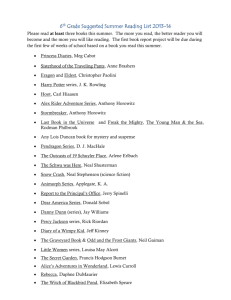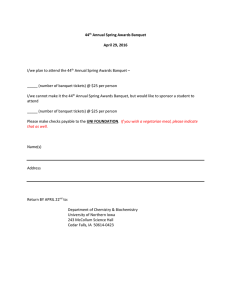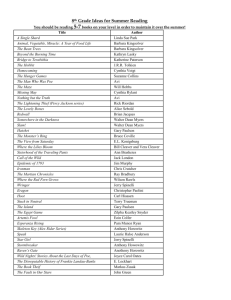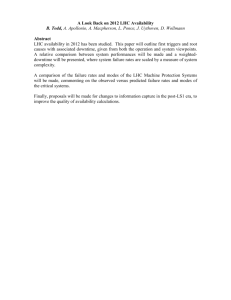The LHC to Test pQCD vs. AdS/CFT Heavy Quark Energy Loss
advertisement
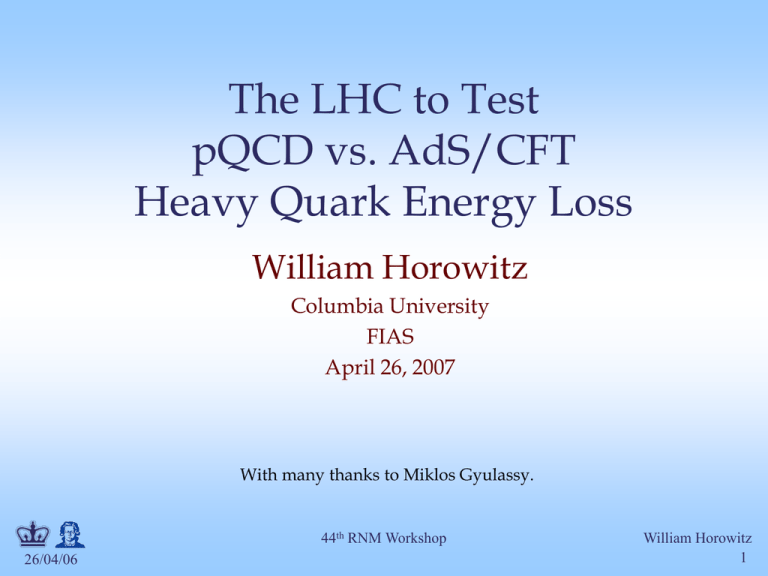
The LHC to Test pQCD vs. AdS/CFT Heavy Quark Energy Loss William Horowitz Columbia University FIAS April 26, 2007 With many thanks to Miklos Gyulassy. 44th RNM Workshop 26/04/06 William Horowitz 1 Good Signs for pQCD at RHIC: (circa 2005) Y. Akiba for the PHENIX collaboration, hep-ex/0510008 – Consistency: RAA(h)~RAA(p) – Null Control: RAA(g)~1 – GLV Prediction: Theory~Data for reasonable fixed L~5 fm and dNg/dy~dNp/dy 44th RNM Workshop 26/04/06 William Horowitz 2 Trouble for wQGP Picture - too h/s too small • veHydro large 2 too small A. H. Feng, and J. Jia, C71:034909 (2005) M. Drees, Djorjevic, M. Gyulassy, R.Phys. Vogt,Rev. S. Wicks, Phys. Lett. (first byD.E.Teaney, Shuryak, Phys. Rev. C66:027902 (2002)) Rev. C68, 034913 (2003) B632:81-86 (2006) Phys. 44th RNM Workshop 26/04/06 William Horowitz 3 Strong Coupling • The supergravity double conjecture: QCD SYM IIB – IF super Yang-Mills (SYM) is not too different from QCD, & – IF Maldecena conjecture is true – Then a tool exists to calculate stronglycoupled QCD in SUGRA 44th RNM Workshop 26/04/06 William Horowitz 4 Ideal Hydro? Hydro merely • pQCD: h/s ~ 1 propagates initial • AdS: universal lower bound for allits results conditions; infinitely coupled systems ~ 1/4p are h/s highly dependent on them • AdS success? T. Hirano, U. W. Heinz, D. Kharzeev, R. Lacy, Y. Nara, Phys. Lett. B636:299-304 (2006) •Glauber initial state => ideal (ST) hydro •CGC initial state => viscous (pQCD) hydro Must understand initial state better before reaching a conclusion: A. Adil, M. Gyulassy, T. Hirano, Phys. Rev. D73:074006 (2006) 44th RNM Workshop 26/04/06 William Horowitz 5 Simultaneous p, e- Suppression • pQCD is not falsified: Naïve pQCD => large mass, small loss –• Elastic loss? -R • But p, h R ~ e – Uncertainty in AAc, b AA! contributions – In-medium fragmentation? – Resonances? H. Van Hees, V. Greco, and R. Rapp, Phys. Rev. C73, 034913 (2006) A. Adil and I. Vitev, hep-ph/0611109 S. Wicks, WH, M. Gyulassy, and M. Djordjevic, nucl-th/0512076 44th RNM Workshop 26/04/06 William Horowitz 6 Simultaneous RAA, v2 Description – Energy loss translates spatial anisotropy of medium to jets WH, Acta Phys. Hung. A27:221-225 PHENIX, Phys. Rev. Lett. 98, 172301 (2007) • RAA and v2 are thus anticorrelated • First seen for pions, no nonperturbative model reproduces both RAA and v2 • Observed for e-, too • No known solution to the puzzle 44th RNM Workshop 26/04/06 William Horowitz 7 Strings, Jets, and the LHC • Langevin model – Collisional energy loss for heavy quarks – Restricted to low pT – pQCD vs. AdS/CFT computation of D, the diffusion coefficient • ASW model – Radiative energy loss model for all parton species – pQCD vs. AdS/CFT computation of – Considerable debate over its magnitude • ST drag calculation – Equation for infinitely massive quark moving with constant v through infinitely coupled SYM at uniform T – not yet used to calculate observables: let’s do it! 44th RNM Workshop 26/04/06 William Horowitz 8 Regimes of Applicability • String Regime – Large Nc, constant ‘t Hooft coupling ( ) • Small quantum corrections – Large ‘t Hooft coupling • Small string vibration corrections – Only tractable case is both limits at once • Classical supergravity (SUGRA) • RHIC/LHC Regime – Mapping QCD Nc to SYM is easy, but coupling is hard aS runs whereas aSYM does not: aSYM is something of an unknown constant • Taking aSYM = aS = .3 (D/2pT~1); aSYM ~ .05 => D/2pT~3 • LHC medium density predictions vary by factor of 2 44th RNM Workshop 26/04/06 William Horowitz 9 Looking for a Robust, Detectable Signal – Use large LHC pT reach and identification of c and b to distinguish • RAA ~ (1-e(pT))n(pT), where pf = (1-e)pi (i.e. e = 1-pf/pi) • Asymptotic pQCD momentum loss: erad ~ a3 L2 log(pT/Mq)/pT • String theory drag momentum loss: eST ~ 1 - Exp(-m L), m = plT2/2Mq S. Gubser, Phys.Rev.D74:126005 (2006) – Independent of pT and strongly dependent on Mq! – T2 dependence in exponent makes for a very sensitive probe – Expect: eQCD 0 vs. eAdS indep of pT!! • dRAA(pT)/dpT > 0 => pQCD ; dRAA(pT)/dpT < 0 => ST 44th RNM Workshop 26/04/06 William Horowitz 10 Models • AdS/CFT Drag – “Obvious”: as = aSYM, TSYM = TQCD • D/2pT = 3 inspired: as = .05, t0 = 1 • Hydro inspired: as = .3, t0 = .6 – “Alternative”: l = 5.5, TSYM = TQCD/31/4 • WHDG convolved radiative and collisional energy loss – as = .3, t0 = .2 • WHDG radiative energy loss (similar to ASW) – = 40, 100 • All use realistic, nonuniform medium with Bjorken expansion 44th RNM Workshop 26/04/06 William Horowitz 11 LHC c, b RAA pT Dependence – Full numerical calculation shows ST RAA decreases with pT (as compared to strong increase for pQCD) – Saturation, or fragility, occurs at a much smaller RAA due to realistic modeling of the medium 44th RNM Workshop William Horowitz 26/04/06 12 A Cleaner Signal • But what about the interplay between mass and momentum? – Take ratio of c to b RAA(pT) • pQCD: Mass effects die out with increasing pT RcAA(pT)/RbAA(pT) ~ 1 - a3 n(pT) L2 log(Mb/Mc) ( /pT) – Ratio starts below 1, asymptotically approaches 1. Approach is slower for higher quenching • ST: drag independent of pT, inversely proportional to mass – Ratio starts below 1, independent of pT 44th RNM Workshop 26/04/06 William Horowitz 13 LHC RcAA(pT)/RbAA(pT) Prediction • Recall the previous plot: – Taking the ratio cancels most normalization differences seen previously – pQCD ratio asymptotically approaches 1, and more slowly so for increased quenching (until quenching saturates) – ST ratio is flat and many times smaller than pQCD at only moderate pT 44th RNM Workshop 26/04/06 William Horowitz 14 Conclusions – PID and large pT reach will give the LHC a unique position to make discoveries in the heavy quark sector • Year 1 of LHC could show qualitative differences between energy loss mechanisms: – dRAA(pT)/dpT > 0 => pQCD; dRAA(pT)/dpT < 0 => ST • Ratio of charm to bottom RAA will be an important observable – Ratio is: flat in ST; asymptotically approaching 1 from below in pQCD • While future AdS/CFT calculations could well alter the ST predictions shown here, it is highly unlikely that a pQCD mechanism can be found that allows mass effects to persist out to momenta orders of magnitude larger than Mq – A measurement of this ratio NOT going to 1 will be a clear sign of new physics: pQCD predicts ~ 3 times increase in this ratio by 30 GeV—this can be observed in year 1 at the LHC 44th RNM Workshop 26/04/06 William Horowitz 15 Conclusions (cont’d) • Additional LHC Goodies: – Adil Vitev in-medium fragmentation results in a much more rapid rise to 1 for RcAA/RbAA with the possibility of breaching 1 and asymptotically approaching 1 from above – Surface emission models (although already unlikely as per p v2(pT) data) predict flat in pT c, b RAA, with a ratio of 1 – Mach cone may be due to radiated gluons: from pQCD the away-side dip should widen with increasing parton mass – Moderately suppressed radiative only energy loss shows a dip in the ratio at low pT; convolved loss is monotonic 44th RNM Workshop 26/04/06 William Horowitz 16 Backups: LHC p Predictions 44th RNM Workshop 26/04/06 William Horowitz 17 Suppression of AWS • AWS pQCD-based controlling parameter nonperturbatively large to fit RHIC data must be -pQCD gives = c e3/4, where c ~ 2; c ~ 8-20 required for RHIC data -Needed because radiative only energy loss (and > 1? R = (1/2) L3) K. J. Eskola, H. Honkanen, C. A. Salgado, and U. A. Wiedemann, Nucl. Phys. A747:511:529 (2005)Workshop 44th RNM 26/04/06 William Horowitz 18 LHC p Predictions WH, S. Wicks, M. Gyulassy, M. Djordjevic, in preparation • Our predictions show a significant increase in RAA as a function of pT • This rise is robust over the range of predicted dNg/dy for the LHC that we used • This should be compared to the flat in pT curves of AWSbased energy loss (next slide) • We wish to understand the origin of this difference 44th RNM Workshop 26/04/06 William Horowitz 19 Comparison of LHC p Predictions (a) (b) K. J. Eskola, H. Honkanen, C. A. Salgado, and U. A. Wiedemann, Nucl. Phys. A747:511:529 (2005) A. Dainese, C. Loizides, G. Paic, Eur. Phys. J. C38:461474 (2005) Curves of ASW-based energy loss are flat in pT 44th RNM Workshop 26/04/06 William Horowitz 20 Why ASW is Flat • Flat in pT curves result from extreme suppression at the LHC – When probability leakage P(e > 1) is large, the (renormalized or not) distribution becomes insensitive to the details of energy loss • Enormous suppression due to: – Already (nonperturbatively) large suppression at RHIC for ASW – Extrapolation to LHC assumes 7 times RHIC medium densities (using EKRT) » Note: even if LHC is only ~ 2-3 times RHIC, still an immoderate ~ 30-45 • As seen on the previous slide, Vitev predicted a similar rise in RAA(pT) as we do – Vitev used only radiative loss, Prad(e), but assumed fixed path – WHDG similar because elastic and path fluctuations compensate 44th RNM Workshop 26/04/06 William Horowitz 21 Conclusions • LHC RAA(pT) data will distinguish between energy loss models – GLV Rad+El+Geom predicts significant rise in pT – ASW type models predict flat pT dependence 44th RNM Workshop 26/04/06 William Horowitz 22 Backup Slides 44th RNM Workshop 26/04/06 William Horowitz 23 RHIC e- 44th RNM Workshop 26/04/06 William Horowitz 24 RHIC c, b RAA(pT) 44th RNM Workshop 26/04/06 William Horowitz 25 RHIC RcAA(pT)/RbAA(pT) 44th RNM Workshop 26/04/06 William Horowitz 26 n(pT) 44th RNM Workshop 26/04/06 William Horowitz 27 Hydro Initial State Hirano and Nara(’04), Hirano et al.(’06) Kuhlman et al.(’06), Drescher et al.(’06) 44th RNM Workshop 26/04/06 William Horowitz 28 Regimes of Applicability • String Regime – Large Nc, constant ‘t Hooft coupling ( ) • Small quantum corrections – Large ‘t Hooft coupling • Small string vibration corrections – Only tractable case is both limits at once • Classical supergravity (SUGRA) • RHIC/LHC Regime – Mapping QCD Nc to SYM is easy, but coupling is hard aS runs whereas aSYM does not: aSYM is something of an unknown constant – Taking aSYM = aS = .3 gives l ~ 10 Taking aSYM ~ .05 => l ~ 1.8 (keep in mind for later) 44th RNM Workshop 26/04/06 William Horowitz 29 Langevin Scheme – Langevin equations (assumes gv ~ 1 to neglect radiative effects): – Relate drag coef. to diffusion coef.: – IIB Calculation: ST here • Use of Langevin requires relaxation time be large compared to the inverse temperature: 44th RNM Workshop 26/04/06 William Horowitz 30 Plugging in Numbers – Langevin pT reach: • gv(8 GeV e- from c) ~ 11 – D/(2pT) = 4/l1/2 from ST: • aSYM = aS = .3 => D/(2pT) ~ 1 – Oversuppresses RAA • aSYM ~ .05 required for D/(2pT) ~ 3 – Mass constraint, (for T = 350 MeV) • aSYM = .3 this gives ~ .6 GeV • aSYM = .05 this gives ~ .25 GeV – Both charm and bottom satisfy this condition – Not entirely unreasonable 44th RNM Workshop 26/04/06 William Horowitz 31 44th RNM Workshop 26/04/06 William Horowitz 32 44th RNM Workshop 26/04/06 William Horowitz 33 44th RNM Workshop 26/04/06 William Horowitz 34 44th RNM Workshop 26/04/06 William Horowitz 35 Strings, Jet Physics, and the LHC: Looking for a Signal • Use large LHC pT reach and identification of c and b to distinguish – RAA ~ (1-e(pT))n(pT), pf = (1-e)pi – Asymptotic pQCD momentum loss: erad ~ a3 L2 log(pT/Mq)/pT – String theory drag momentum loss: eST ~ 1 - Exp(-m L), m = plT2/2m S. Gubser, Phys.Rev.D74:126005 (2006) – Independent of pT and strongly dependent on m!! – T2 dependence makes for a very sensitive probe 44th RNM Workshop 26/04/06 William Horowitz 36
